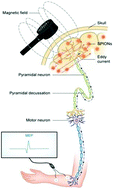Enhancing the effects of transcranial magnetic stimulation with intravenously injected magnetic nanoparticles†
Abstract
Transcranial magnetic stimulation (TMS) is a non-invasive and clinically approved method for treating neurological disorders. However, the relatively weak intracranial electric current induced by TMS is an obvious inferiority which can only produce limited treatment effects in clinical application. The present study aimed to investigate the possibility of enhancing the effects of TMS with intravenously administrated magnetic nanoparticles. To facilitate crossing of the blood–brain barrier (BBB), the superparamagnetic iron oxide nanoparticles (SPIONs) were coated with carboxylated chitosan and poly(ethylene glycol). To aid the nanoparticles in crossing the BBB and targeting the predesigned brain regions, an external permanent magnet was attached to the foreheads of the rats before the intravenous administration of SPIONs. The electrophysiological tests showed that the maximum MEP amplitude recorded in an individual rat was significantly higher in the SPIONs + magnet group than in the saline group (5.78 ± 2.54 vs. 1.80 ± 1.55 mV, P = 0.015). In the M1 region, biochemical tests detected that the number density of c-fos positive cells in the SPIONs + magnet group was 3.44 fold that of the saline group. These results suggest that intravenously injected SPIONs can enhance the effects of TMS in treating neurological disorders.



 Please wait while we load your content...
Please wait while we load your content...